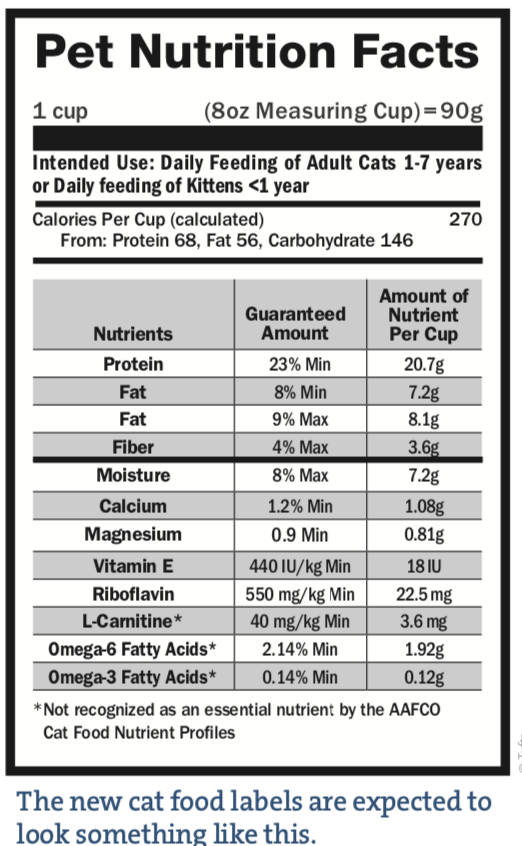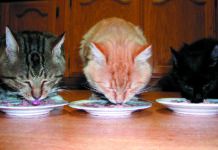I
t looks like reading nutrition information on cat food labels may get easier. After years of discussion and input from different sources, the Association of American Feed Control Officials, known by the acronym AAFCO, has put forth a proposal that would get rid of the arcane and difficult-to-understand “Guaranteed Analysis” box on bags and cans of cat food. The intention is to replace it with a “Pet Nutrition Facts” box that is much closer to the “Nutrition Facts” box required on foods for people.
If the proposed changes go through, you’ll be able to see at a glance — rather than having to search — how many calories are in a serving of cat food, whether that’s a cup, a can, or some other easily understood unit of measure. Moreover, you’ll be able to see right away how many calories come from protein, fat, and carbohydrate. These are the three calorie-containing nutrients in food.
Furthermore, the label will say how much of various nutrients is in a serving of the food. It’s a big step forward for people who want to do right by their pets. And it’s not the only helpful change under consideration.
Statement of
Nutritional Adequacy
The Statement of Nutritional Adequacy is arguably the most important piece of information on a package of cat food. It states whether the food contains all the nutrients that are essential for a cat at her particular stage of life, whether that’s kittenhood, adulthood, or during pregnancy and nursing. Ironically, it’s the hardest piece of information to find, smushed up on the side of the bag or in some other hard-to-find spot in tiny print. It doesn’t even always have a heading called “Statement of Nutrition Adequacy” to guide you to it.
But if the proposed AAFCO changes go through, manufacturers will have to include specific icons right on the front of the package that make it clear at a glance if the product is nutritionally up to snuff and for which stage of a cat’s life. If a food is not nutritionally complete and balanced — perhaps it’s a treat or pill wrap — the label will have to make that clear, as well. This will be a particularly welcome change because “there are a number of diets currently on the market that are not nutritionally balanced but are labeled in a way that can mislead consumers into thinking that they are,” says board-certified veterinary nutritionist Cailin Heinze, VMD.
Fiber info to be updated
If you look on a cat food label right now, it will tell you the food’s crude fiber content. That gives an incomplete picture because crude fiber contains less than half the fiber that is actually in some foods. The new label would tell how much total dietary fiber there is, just like for a food that people eat. It’s a much more accurate measure of the fiber in a diet and will make it somewhat easier to compare fiber content from food to food.
Safe handling instructions
If the proposed changes go through, cat food will require safe handling instructions. These could be in the form of standardized icons. For instance, there might be an icon with a refrigerator reminding people either to refrigerate or throw out unused food. Another icon might have a garbage can with the words, “Throw out when in doubt.”
The bugaboo
Dr. Heinze is pleased about some of the proposed changes, which consumers might start seeing on labels before long. But she points out that listing nutrient content by volume — cup or can, for instance — can make it hard to compare foods because a cup of one food might contain a very different number of calories than a cup of a different food.
Let’s say, for instance, that a cup of a particular cat food contains 100 milligrams of calcium, while a cup of a different food contains 150 milligrams of calcium. That might make it seem like the second food offers much more calcium, but the second food may have 400 calories a cup, whereas the first food has only 270 calories per cup. In other words, calorie for calorie, the two foods offer pretty much the same amount of calcium even though the two labels make it look otherwise at first glance.
To do the math, you’ll need to look at the amount of nutrient per a given number of calories. In other words, even though the new nutrient content on labels will be a big improvement, they won’t take away the confusion entirely. Don’t put away your calculators just yet.



